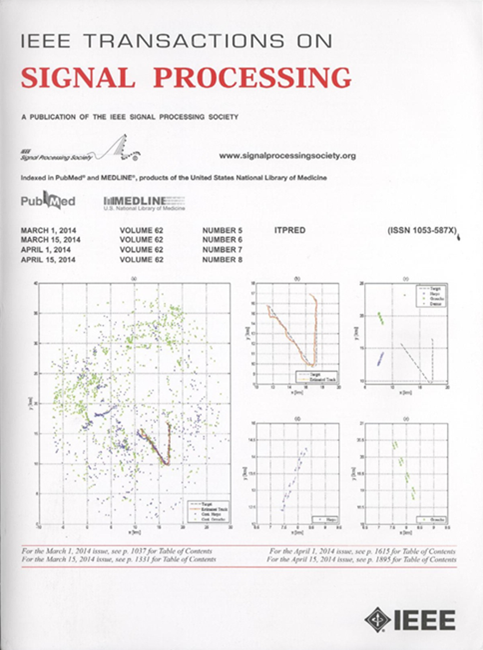用于暂态信号检测的无穷阶乘线性动力系统
IF 5.8
2区 工程技术
Q1 ENGINEERING, ELECTRICAL & ELECTRONIC
引用次数: 0
摘要
从背景信号中准确检测出感兴趣的瞬态信号是信号处理的基本任务之一。最近的方法假设存在单一背景源,并使用线性动力系统表示背景信号,但这种假设可能无法捕捉具有多源的现代电磁环境的复杂性。为了解决这一限制,本文提出了一种在由未知数量的发射器组成的背景下检测瞬态信号的方法。提出的方法包括两个主要任务。首先,建立了无限阶乘线性动力系统的贝叶斯非参数模型。所开发的模型基于马尔可夫印度自助餐过程,能够对无限数量的背景源进行表示和参数学习。本文还设计了一种无限阶乘线性动力系统的参数学习方法,该方法采用切片采样和粒子Gibbs带祖先采样。其次,定义了理论上简单的广义似然比停止时间,但它在计算上对阶乘线性动力系统是不可行的。为了方便计算,我们推导了阶乘卡尔曼前向滤波方法,并为底层模型设计了依赖关系结构,实现了停止时间的递归定义。然后,对所提出的停车时间的统计性能进行了研究。数值仿真验证了所提方法的有效性和理论结果的正确性。在通信干扰条件下的脉冲信号检测实验结果验证了该方法的有效性和优越性。本文章由计算机程序翻译,如有差异,请以英文原文为准。
Infinite Factorial Linear Dynamical Systems for Transient Signal Detection
Accurately detecting the transient signal of interest from the background signal is one of the fundamental tasks in signal processing. The most recent approaches assume the existence of a single background source and represent the background signal using a linear dynamical system, but this assumption might fail to capture the complexities of modern electromagnetic environments with multiple sources. To address this limitation, this paper proposes a method for detecting the transient signal in a background composed of an unknown number of emitters. The proposed method consists of two main tasks. First, a Bayesian nonparametric model called the infinite factorial linear dynamical systems is developed. The developed model is based on the Markov Indian buffet process and enables the representation and parameter learning of an unbounded number of background sources. This study also designs a parameter learning method for the infinite factorial linear dynamical systems using slice sampling and particle Gibbs with ancestor sampling. Second, a theoretically straightforward generalized likelihood ratio stopping time is defined, but it is computationally infeasible for factorial linear dynamical systems. To facilitate the computation, we derive the factorial Kalman forward filtering method and design a dependence structure for the underlying model, enabling the stopping time to be defined recursively. Then, the statistical performance of the proposed stopping time is investigated. Numerical simulations demonstrate the effectiveness of the proposed method and the validity of the theoretical results. The experimental results of the pulse signal detection under the condition of communication interference confirm the effectiveness and superiority of the proposed method.
求助全文
通过发布文献求助,成功后即可免费获取论文全文。
去求助
来源期刊

IEEE Transactions on Signal Processing
工程技术-工程:电子与电气
CiteScore
11.20
自引率
9.30%
发文量
310
审稿时长
3.0 months
期刊介绍:
The IEEE Transactions on Signal Processing covers novel theory, algorithms, performance analyses and applications of techniques for the processing, understanding, learning, retrieval, mining, and extraction of information from signals. The term “signal” includes, among others, audio, video, speech, image, communication, geophysical, sonar, radar, medical and musical signals. Examples of topics of interest include, but are not limited to, information processing and the theory and application of filtering, coding, transmitting, estimating, detecting, analyzing, recognizing, synthesizing, recording, and reproducing signals.
 求助内容:
求助内容: 应助结果提醒方式:
应助结果提醒方式:


